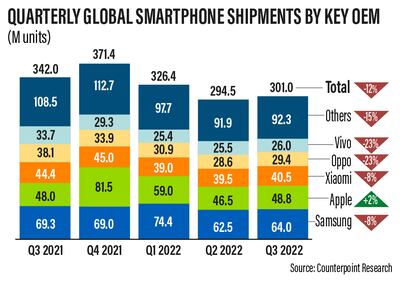Global smartphone shipments are expected to decline in 2023, a swing from a previous growth forecast, as macroeconomic challenges and weak consumer demand would weigh on the sector, a study from Counterpoint Research showed.
Shipments of the top consumer electronic device are seen to decline 2 per cent annually to 1.262 billion units in 2023, compared to an estimated 1.240 billion this year, the Hong Kong-based research firm said in its latest market update.
That is a U-turn from an earlier forecast of a 6 per cent year-on-year increase in shipments next year. The estimated 2022 figure would be an 11 per cent decline from the 1.391 billion units shipped last year, and a 15 per cent drop from 1.471 billion in 2019, the year before the Covid-19 pandemic struck, the study showed.
The market is also expected to underperform through the first half of 2023 — weaker than expected — and would only recover by the third quarter, it said.
Factors from macroeconomic issues to challenges stemming from geopolitical events will continue to dampen the sector, Peter Richardson, vice president at Counterpoint, wrote in the report.
“Persistent inflation, expectations of future interest rate hikes, souring corporate earnings, China’s stalled economy, the protracted Ukraine-Russia war, political turmoil in Europe and a sweeping new set of export controls on China from the US, all contribute to the downward adjustment of the smartphone market forecast," he said.
"Original equipment manufacturers [OEMs] focusing on the premium segment, which is more resilient than the low to mid-end, are better positioned to deal with these issues, with deep technological expertise and diversified businesses capable of weathering the storm.”
Global shipments of smartphones dropped to about 301 million units in the third quarter of 2022, the lowest level in eight years, as geopolitical factors affecting the global economy continued to subdue market demand, Counterpoint said in their last quarterly update.
In the second quarter of this year, shipments dipped below that level — the first time since the onset of Covid-19 in 2020.
As such, the sector is on track for another annual decline: in the first nine months of this year, smartphone shipments hit about 921.9 million and are unlikely to surpass 2021's 1.39 billion units, which marked the first positive growth since 2017.
The pandemic triggered disruptions in supply chains owing to widespread lockdowns that lasted for months, resulting in parts shortages that affected smartphone makers. The market, however, is recovering gradually.
Smartphone shipments in 2022 were boosted by a recovery from Samsung Electronics and Apple, the world's largest mobile phone makers, helping to push them above the 300-million mark in the three months ended September.

Replacement cycles, or the average time consumers take before buying new smartphones, in 2022 are expected to hit 43 months, the highest level ever, said Liz Lee, an associate director at Counterpoint.
“Given an increase in average selling prices and a consequent long replacement cycle, we expect annual smartphone shipments are unlikely to come back to pre-Covid levels for the short-term," she said.
"Although the replacement cycle gets shortened sequentially from next year, it will stay above 40 months.”
Meanwhile, the global market for 5G devices is expected to show "healthy growth" from 2024 as manufacturers are expected to ramp up the release of low- and mid-priced 5G devices, Counterpoint said.
This will be due to smartphone makers and telecom operators aggressively promoting 5G, plus the "sufficient" incentives in many markets to convince consumers to switch to current standard of mobile communications.
New smratphone form factors, most notably as foldables, are also projected to fuel the growth of the premium smartphones segment.
"With more OEMs entering the foldable segment, the market will see the prices of these phones stabilizing and the foldable segment growing to become more prominent along with the 5G segment," Counterpoint said.





